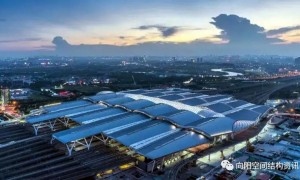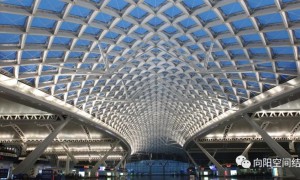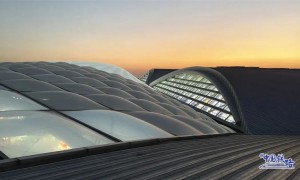本文转载自公众号搜建筑
前海湾腾讯总部园区的智慧城区方案
MVRDV
经过为期两年的研究和设计,MVRDV展示了他们为下一代腾讯总部园区规划的方案和其中的研究过程。该项目位于深圳前海湾(又名“大铲湾”)的优势区位,占地133公顷。
腾讯的规划目标是建立一个完整的科技园区,包括办公区、为年轻员工提供的公寓、商业单元、公共设施、学校和会议中心。
MVRDV的方案和研究展示了这个科技园区的形成过程:各种功能被整合到一个仿若连绵起伏山脉的智能城区,同时围绕基地创造一个滨水公园。
Following a two-year process, today MVRDV is revealing their competition entry and research process for the next Tencent headquarters campus. Located on a 133-hectare site in a prominent location in Qianhai Bay, Shenzhen, Tencent’s brief called for what is nothing short of an entire urban district including offices, homes for Tencent employees, commercial units, public amenities, schools, and a conference centre. MVRDV’s proposals and studies show the process of the making of this campus and conclude with these components integrated into a smart city district shaped like a continuous undulating mountain range, with a waterfront park winding its way around the base.
图/Image: © MVRDV
MVRDV为腾讯园区设计的方案包含一项复杂的研究,最终圆满呈现了一个连绵起伏像山脉一样的智慧园区。MVRDV’s proposal for the Tencent campus included a complex research project culminating in a smart city district shaped like a continuous undulating mountain range.
中国科技巨头腾讯为了适应业务的飞速发展,在位于深圳的总部——腾讯海滨大厦刚竣工时,就立刻着手计划在深圳前海湾建立新的总部。
但腾讯下一代总部的规模达到另一个层次:该项目总建筑面积为200万平方米,可容纳8-10万名员工。
To accommodate their meteoric growth, Chinese tech giant Tencent began plans for its new headquarters in Qianhai Bay almost immediately after completion of their current Shenzhen headquarters, the Tencent Seafront Towers. But their ambition for their next home is on another level: the brief asked for a total of 2 million square metres of floor space to accommodate offices for 80,000–100,000 employees.
图/Image: © MVRDV
腾讯新总部计划总建筑面积为200万平方米,可容纳8-10万名员工。
The Tencent brief asked for a total of 2 million square metres of floor space to accommodate offices for 80,000–100,000 employees.
腾讯的新总部不仅拥有更大的体量,同时在技术层面上也充满了宏伟的愿景。
腾讯的经营理念是将科技带来的“用户价值”及其为日常生活带来的便利放在首位,在这种价值观下,腾讯希望新的园区能成为智慧城区的典范,向人们展示最新科技改变城市的潜力。
Beyond its scale, the brief is also technologically ambitious. Expanding on their mission statement, which foregrounds the “user value” of technology and the benefits it can bring to everyday life, they requested that their new campus be an exemplary smart city district, demonstrating the city-altering potential of the latest urban technologies.
图/Image: © MVRDV
腾讯园区被设想为一个由100多座建筑组成的网格状园区,屋顶是起伏的光伏板。
MVRDV’s studies envision the Tencent campus as a grid of over 100 buildings with an undulating roof of photovoltaic panels.
MVRDV的一系列研究在竞赛中圆满呈现,腾讯园区被设想为一个由100多座建筑组成的网格状园区。
屋顶起伏的光伏板以及多座将建筑连接在一起的桥梁,构成一个让人联想到绵延山脉的连续表面。
在建筑底部,滨水公园沿着场地的东侧蜿蜒盘旋,汇入前海湾。滨水公园将邻近建筑的低层扩展成被绿色渲染的梯田式露台。
MVRDV’s studies, culminating in the competition entry, envision the Tencent campus as a grid of over 100 buildings with an undulating roof of photovoltaic panels, with multiple bridges connecting buildings to form a continuous surface reminiscent of a mountain range. At the foot of the buildings, a waterfront park winds its way along the entire eastern side of the site, facing into the Qianhai Bay. This park also expands up the lower levels of the adjacent buildings to form greenery-filled terraces.
图/Image: © MVRDV
在建筑底部,滨水公园沿着场地的东侧蜿蜒盘旋,汇入前海湾。
At the foot of the buildings, a waterfront park winds its way along the entire eastern side of the site, facing into the Qianhai Bay.
整座公园内遍布该区域的公共建筑,包括一所学校、一所幼儿园、一个体育中心和一个数据中心等。
公园的南端有园区内最引人注目的建筑,一座仿佛山脚下石块的会议中心。该会议中心位于前海湾的入口处,它将成为彰显腾讯国际影响力的标志。
Placed throughout the park are many of the public buildings for the district, including a school and kindergarten, a sports centre, and data centre, among others. At the southern end of the park is the most notable building on the campus, a conference centre shaped like a rock at the foot of the hills. Flanking the entrance to Qianhai Bay, this conference centre forms an iconic marker of Tencent’s global influence.
图/Image: © MVRDV
公园的南端有园区内最引人注目的建筑,一座仿佛山脚下石块的会议中心
At the southern end of the park is the most notable building on the campus, a conference centre shaped like a rock at the foot of the hills
在办公区中心地带的一个十字路口,坐落着园区的“心脏”——信息广场,由邻近的四座建筑各开辟一角组成。从入住率到碳排放量,这个圆形的空间向人们展示了腾讯园区日常运作的各种相关数据。
“智慧城市”介入的另一个重点是园区的交通策略:在园区的东面,高速公路可直达四个地下停车场,地上交通网络则留给无人驾驶汽车和循环班车,保证员工和居民出行的便利性。
此外,通往市中心的地铁和公交线路沿场地的东西两侧运行,将腾讯园区与深圳其他区域连接起来。
At an intersection of the street grid in the heart of the office zone is the project’s “beating heart”, the information plaza. This spherical space, carved from the corners of four adjacent buildings, displays data related to the everyday functioning of the Tencent campus, from occupancy rates to carbon usage. Another key “smart city” intervention is the transportation strategy for the campus: along the eastern side of the site, a highway gives access to four underground car parks, but the street grid itself is reserved for autonomous cars and a shuttle bus loop that ensure employees and residents can move around easily. In addition, metro and bus lines to the city run along both eastern and western edges of the site to connect the Tencent campus to the rest of Shenzhen.
图/Image: © MVRDV
整座公园内遍布该区域的公共建筑,包括一所学校、一所幼儿园、一个体育中心和一个数据中心等
Many of the public buildings for the district, including a school and kindergarten, a sports centre, and data center, are placed throughout the park
“我们希望我们为腾讯所做的研究和设计,能够向人们证明智慧城市也将是一个绿色城市。
” MVRDV联合创始人Winy Maas表示:“园区中心的未来主义数据中心,加上无处不在的智慧城市元素,腾讯员工会觉得自己被科技包围了,但他们也被自然包围着。
员工可以在很短的步行距离内到达斗折蛇行的公园,绿色的阶梯状露台环绕着他们。”
“Our studies and competition entry for Tencent are an attempt to show that the smart city is also the green city”, says MVRDV founding partner Winy Maas. “With ubiquitous smart city elements, headlined by a futuristic data hub at the heart of the campus, Tencent employees would feel enveloped by technology. But they are also literally surrounded by nature, with the serpentine park always within a short walking distance, and green terraces all around them.”
图/Image: © MVRDV
设计团队设计了28种不同的外轮廓方案,并将它们排列成一个 “谱系”
The design team developed 28 different outline designs, ordering them into a design “genealogy”
在腾讯园区的设计过程中,为了获得现代科技园区的最优方案,MVRDV进行了一个复杂的研究。
设计团队设计了28种不同的外轮廓方案,并将它们排列成一个 “谱系”,当设计团队为初始方案添加更多关键品质时,这个“谱系”进化出多个分支。“
所有的研究都按逻辑汇编成脚本,这将为设计和维护未来的智慧城市提供一种新的方式,”Winy Maas补充道:“最终提交的竞赛作品综合反映了在这个反复打磨的设计过程中MVRDV收获的一切,一个多样化、灵活、绿色、动态、开放、适应性强,最重要的是——一个有远见卓识的科技园区。”
In their design process for the Tencent Campus, MVRDV conducted a complex research project to arrive at the optimal design for a modern tech campus. The design team developed 28 different outline designs, ordering them into a design “genealogy” that traced multiple evolutionary branches as the team sought to add key qualities to their previous designs. “All studies were scripted, thus preparing a new way of designing and maintaining future smart cities”, added Winy Maas. “The final competition entry was a synthesis of everything learned in this iterative process, resulting in a tech campus that is diverse, flexible, green, dynamic, open, adaptable, and above all, visionary.”
建筑师:MVRDV
地点:深圳
面积:200万平方米
(如有侵权,请您联系我们删除)







